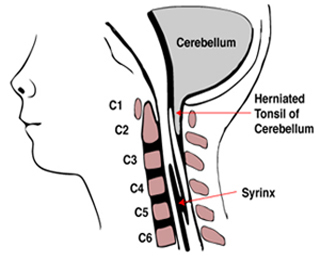Chiari Malformation
Definition: Chiari malformation describes a group of conditions that are very different but share in common the characteristic that a small portion brain tissue protrudes froDr. Aniruddh Kulkarni spinal canal. They were all originally described by an Austrian pathologist, Hans Chiari.

The rates of Chiari Malformation, Drawing of chiari malformation with a syrinx Type I are not known, as many people may have Chiari Malformation, Type I without any symptoms. In this context, it rarely requires surgical treatment. Symptoms associated with Chiari Malformation, Type I can develop during childhood or adulthood
Chiari Malformation, Type II is a developmental condition that is always present at birth and is almost exclusively associated with a condition known as myelomeningocele, or spina bifida. Although most children with Chiari Malformation, Type II do not require surgical treatment for the Chiari Malformation, they all require surgical treatment for the myelomeningocele.
Symptoms: Chiari Malformation, Type I The symptoms and signs of a Chiari Malformation, Type I are related to the compression of the cerebellar tonsils, which are the small portion of the brain that protrudes through the base of the skull, or due to compression of the lower portion of the brainstem. Chiari Malformation, Type I may also be associated with the development of a fluid collection within the spinal cord, known as a syrinx, or with scoliosis. These conditions may lead to sensation or strength changes in the arms or legs. The most common symptom is headache, which occurs in the back of the head and the neck, and is increased by coughing or sneezing. In infants and children, headaches may manifest as irritability or crying, and the pain may be associated with arching of the neck in a hyperextended posture.
Dr. Aniruddh KulkarniLess common symptoms may include dizziness, an impaired ability to coordinate movement, double vision, and involuntary, rapid, downward eye movements. Because many symptoms of Chiari malformation can also be associated with other disorders, a thorough medical evaluation is important. Headache, for example, can be caused by migraines, sinus disease or other causes.
Chiari Malformation, Type II The symptoms and signs related to Chiari Malformation, Type II are often complex, as patients with this condition usually have a condition known as hydrocephalus, as well. Typical symptoms include difficulty swallowing and difficulty breathing.
Evaluation: The diagnostic process begins with your primary care doctor or neurologist taking your medical history and giving you a complete physical examination. Your doctor will ask whether you're having symptoms such as head and neck pain, and will ask you to describe them. He or she will also check your fine motor skills and swallowing ability. If you have symptoms such as head pain, and the exact cause isn't apparent to your doctor, he or she may recommend a radiographic study, such as a computed tomogram (CT) or Magnetic Resonance Image (MRI). These studies are the best tools to evaluate for the presence of a Chiari Malformation.
Chiari Malformation, Type I The severity of symptoms related to Chiari Malformation, Type I is highly variable. The majority of patients do not require surgical treatment. Many have relief of headaches with over the counter pain medications. For cases in which a patient has severe symptoms Drawing of surgery site to decompress Chiari malformationthat clearly result from the Chiari Malformation, there is not effective medical treatment at this time.
Chiari Malformation, Type II Although patients with Chiari Malformation, Type II require surgical treatment for the associated spina bifida and often require surgical treatment for hydrocephalus, the majority will not require surgical decompression of their Chiari Malformation. In such cases, the patient will have had multiple interactions with her/his neurosurgeon prior to making a decision to pursue surgical treatment.

Reducing pressure by surgery: The most effective treatment for patients with severe symptoms from Chiari Malformation, Type I, is a surgical procedure known as posterior fossa decompression. In this procedure, a portion of the bone at the bottom of the skull is removed in order to allow more space for the cerebellum. In adults and some children, the protective membrane overlying the brain, or dura mater, is also opened and a patch may be sewn into position, also to create more space for the cerebellum. In some children, it is not necessary to open the dura mater. Surgery usually takes 2-3 hours and the patient leaves the hospital 2-4 days after surgery.
